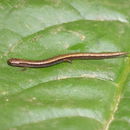Description
provided by AmphibiaWeb articles
This is a large species of Thorius. Adult males have an average length of 25.9 mm (range 21.1-29.3 in 21 males). Adult females have an average length of 29.1 mm (range 22.6-34.9 in 20 females). Head size is relatively narrow. SL averages 8.1 times the head width in males (range 6.8-8.9 in 10 males). The mean SL in females is 8.9 (range 8.3-9.7 in 10 females). The snout is more rounded in females and somewhat more pointed in males. Nostrils are oval with an average major axis to minor axis ratio of 1.6 (range 1.3-2.0). There is a suborbital groove intersecting the lip on each side. Teeth are more developed and more numerous in females. The mean number of premaxilliary teeth is 2.1 (range 0-5) in males, and 5.2 (range3-7) in females. The mean number of maxilliary teeth is 13.2 (range 9-21) in males and 21 (range 11-34) in females. The number of vomerine teeth ranges from 6-11 with means of 8.0 and 8.5 in males and females respectively. This species has a relatively robust trunk and short limbs. Average limb intervals are 6.4 (range 6-7.5) in males and 7.4 (range 7-7.5) in females. The hands and feet are small and narrow. The first and fifth digits are both short and poorly developed. The species has been noted to have a prominent gold dorsal stripe and a pale venter. The stripe may be solid or interrupted by dark markings. The lateral surfaces have light flecking (Hanken and Wake 1994).
Hanken, J., Wake, D. B. (1994). ''Five new species of minute salamanders, genus Thorius (Caudata: Plethodontidae), from Northern Oaxaca, Mexico.'' Copeia, 1994(3), 573-590.
Distribution and Habitat
provided by AmphibiaWeb articles
This is a terrestrial species collected in montane pine-oak-fir forests and upper cloud forest habitat. The known elevation range is 2475-2930 m. The species is known onle from the type localities along Hwy 175 on the north slopes of Cerre Pelon.It is known to be sympatric with T. macdougalli and T. boreas at upper elevations and with T. arboreus at lower elevations (Hanken and Wake 1994).

